Analysis of a Severe Pollution Episode in December 2017 in Sichuan Province
Abstract
:1. Introduction
2. Data and Methodology
2.1. Study Area
2.2. Data Source
2.3. Methods
2.3.1. Depiction of the Pollution Episode
2.3.2. Meteorological Factors
2.3.3. Correlation Analysis
3. Results and Discussion
3.1. Depiction of the Pollution Episode
3.1.1. Analysis of AQI Variation
3.1.2. Analysis of Air Pollutants
3.1.3. Secondary Formation
3.2. Meteorological Factors
3.2.1. Synoptic Circulation
3.2.2. Surface Meteorological Factors
3.2.3. Air Mass Backward Trajectory Analysis
3.2.4. Atmospheric Boundary Layer
3.3. Relationship between Air Pollutants and Meteorological Factors
3.4. Discussion
4. Conclusions
- This pollution process began on 19 December 2017 and ended on 2 January 2018. The main pollution area switched from southeastern Sichuan to northern Sichuan because of the growing effects of external sources. The main pollutants were PM2.5 and PM10 over all of the cities; however, in addition to particulate matter, some cites experienced a concentration burst in specific kinds of pollutants due to motor vehicle exhaust emissions (such as NO2 in Chengdu), the combustion of core fuel (such as CO and SO2 in Panzhihua), and photochemical reactions (such as O3 in Ganzi).
- With respect to circulation, Sichuan experienced ridges that moved eastward across the basin three times and changed the local circulation pattern. Meanwhile, ground meteorological factors (specifically, a low wind speed and high relative humidity) were also conducive to the accumulation of pollutants, resulting in a continuous increase in the pollutants’ concentrations. On 30 December 2017, a low-pressure system that formed in Mongolia brought dust into Sichuan and increased the concentration of particulate matter in the northern region. The atmospheric conditions in other areas became unstable because of the incoming cold air, the pollutants were removed, and the pollution process ended.
- In this pollution process, the most closely related variables between the pollutant concentration and meteorological elements were NO2 and O3 with the ground relative humidity and temperature, the boundary layer height, and the VI. The precursors that were generated from the motor vehicle emissions and coal-fired processes in winter affected the photochemical conversion process in the atmosphere with a high ground temperature and low relative humidity, resulting in a high ozone concentration.
Author Contributions
Funding
Conflicts of Interest
References
- Kang, H.; Zhu, B.; Su, J.; Wang, H.; Zhang, Q.; Wang, F. Analysis of a long-lasting haze episode in Nanjing, China. Atmos. Res. 2013, 120–121, 78–87. [Google Scholar] [CrossRef]
- Tian, G.; Qiao, Z.; Xu, X. Characteristics of particulate matter (PM10) and its relationship with meteorological factors during 2001–2012 in Beijing. Environ. Pollut. 2014, 192, 266–274. [Google Scholar] [CrossRef] [PubMed]
- Bei, N.; Zhao, L.; Xiao, B.; Meng, N.; Feng, T. Impacts of local circulations on the wintertime air pollution in the Guanzhong Basin. China Sci. Total Environ. 2014, 592, 373–390. [Google Scholar] [CrossRef]
- Wikipedia. Available online: https://en.wikipedia.org/wiki/Air_pollution_episode (accessed on 10 March 2019).
- Zeng, S.; Zhang, Y. The Effect of Meteorological Elements on Continuing Heavy Air Pollution: A Case Study in the Chengdu Area during the 2014 Spring Festival. Atmosphere 2017, 8, 71. [Google Scholar] [CrossRef]
- Ning, Z.; Liu, H. Domestic and Abroad Research Status of Atmospheric Boundary Layer. J. EMCC 2017, 27, 12–15. [Google Scholar]
- Kallos, G.; Kassomenos, P.; Pielke, R.A. Transport and Diffusion in Turbulent Fields; Kluwer Academic Publishers: Dordrecht, The Netherlands, 1993; pp. 163–184. [Google Scholar]
- Zhang, Y.; Liu, Z.; Lv, X.; Zhang, Y.; Qian, J. Characteristics of the transport of a typical pollution event in the Chengdu area based on remote sensing data and numerical simulations. Atmosphere 2016, 7, 127. [Google Scholar] [CrossRef]
- Guo, X. Observed and Simulated Research on Climate Characteristic of Air Quality and the Topographic Induced Effects in Sichuan Basin. Master’s Thesis, Nanjing University of Information Science & Technology, Nanjing, China, 2016. [Google Scholar]
- Yu, W.; Luo, X.; Fan, S.; Liu, J.; Feng, Y.; Fan, Q. Characteristics Analysis and Numerical Simulation Study of a Severe Air Pollution Episode over the Pearl River Delta. Res. Environ. Sci. 2011, 24, 645–653. [Google Scholar] [CrossRef]
- Zhang, P.; Jin, Q.; Lu, X.; Li, C.; Jiang, Y. Analysis on environmental factors affecting air pollution in a durative haze weather in January 2013. J. Meteorol. Sci. 2016, 36, 112–120. [Google Scholar]
- The Ministry of Environmental Protection (MEP). Specifications and Test Procedures for PM10 and PM2.5 Sampler; HJ 93-2013; The Ministry of Environmental Protection (MEP): Beijing, China, 2013; pp. 1–15. [Google Scholar]
- The Ministry of Environmental Protection (MEP). Specifications and Test Procedures for Ambient Air Quality Continuous Automated Monitoring System for SO2 NO2 O3 and CO; HJ 654-2013; The Ministry of Environmental Protection (MEP): Beijing, China, 2013; pp. 1–19. [Google Scholar]
- The Ministry of Environmental Protection (MEP). Ambient Air Quality Standard; GB3095-2012; The Ministry of Environmental Protection (MEP): Beijing, China, 2012; pp. 2–3. [Google Scholar]
- The Ministry of Environmental Protection (MEP). Technical Regulation on Ambient Air Quality Index (on Trial); HJ 633-2012; The Ministry of Environmental Protection (MEP): Beijing, China, 2012; pp. 2–4. [Google Scholar]
- The NCAR Command Language (Version 6.4.0); UCAR/NCAR/CISL/TDD: Boulder, CO, USA, 2017.
- Wang, J.; Ogawa, S. Effects of meteorological conditions on PM2.5 concentrations in Nagasaki, Japan. Int. J. Environ. Res. Public Health 2015, 12, 9089–9101. [Google Scholar] [CrossRef] [PubMed]
- Zhang, H.; Lv, M.; Zhang, B.; An, L.; Rao, X. Analysis of the stagnant meteorological situation and the transmission condition of continuous heavy pollution course from 20–26 February 2014 in Beijing-Tianjin-Hebei. Acta Sci. Circumst. 2016, 36, 4340–4351. [Google Scholar]
- Nozaki, K.Y. Mixing Depth Model Using Hourly Surface Observations; Report 7053; USAF Environmental Technical Applications Center: Washington, DC, USA, 1973. [Google Scholar]
- Li, Z.; Chen, J.; Du, Y.; Wang, B. Characteristics of Regional Air Pollution Process in Chengdu and Surrounding Areas. Environ. Sci. Technol. 2015, 38, 125–130. [Google Scholar] [CrossRef]
- Wang, Y.; Yao, L.; Wang, L.; Liu, Z.; Ji, D.; Tang, G.; Zhang, J.; Sun, Y.; Hu, B.; Xin, J. Mechanism for the formation of the January 2013 heavy haze pollution episode over central and eastern China. Sci. China Earth Sci. 2014, 57, 14–25. [Google Scholar] [CrossRef]
- Wang, S.; Liao, T.; Wang, L.; Fan, C.; Xu, J.; Sun, Y. Atmospheric characteristics of a serious haze episode in Xi’an and the influence of meteorological conditions. Acta Sci. Circumst. 2015, 35, 3452–3462. [Google Scholar]
- Wu, D.; Wu, S.; Li, H.; Chen, H. Analysis of the typical haze process in the pearl river delta from 17–23 March 2010. Res. Environ. Sci. 2011, 31, 695–703. [Google Scholar] [CrossRef]
- Wang, Y.; Wang, L.; Zhao, G.; Wang, Y.; An, J.; Liu, Z.; Tang, G. Analysis of Different-Scales Circulation Patterns and Boundary Layer Structure of PM2.5 Heavy Pollutions in Beijing during Winter. Clim. Environ. Res. 2014, 19, 173–184. (In Chinese) [Google Scholar]
- Whiteman, C.D.; Hoch, S.W.; Horel, J.D.; Chaeland, A. Relationship between particulate air pollution and meteorological variables in Utah’s Salt Lake Valley. Atmos. Environ. 2014, 94, 742–753. [Google Scholar] [CrossRef]
- Zhang, Z.; Gong, D.; Mao, R.; Kim, S.; Xu, J.; Zhao, X.; Ma, Z. Cause and predictability for the severe haze pollution in downtown Beijing in November–December 2015. Sci. Total Environ. 2017, 592, 627–638. [Google Scholar] [CrossRef] [PubMed]
- Zhu, B.; Su, J.; Han, Z.; Yin, C.; Wang, T.; Cai, Y. Analysis of a serious air pollution event resulting from crop residue burning over Nanjing and surrounding regions. Remote Sens. Model. Ecosyst. Sustain. VII 2010, 7809, 78090F. [Google Scholar] [CrossRef]
- Zhang, Y.; Xiang, Y.; Chan, L.; Chan, C.; Sang, X.; Wang, R.; Fu, H. Procuring the regional urbanization and industrialization effect on ozone pollution in Pearl River Delta of Guangdong, China. Atmos. Environ. 2011, 45, 4898–4906. [Google Scholar] [CrossRef]
- Jeong, J.; Park, R. Effects of the meteorological variability on regional air quality in East Asia. Atmos. Environ. 2013, 69, 46–55. [Google Scholar] [CrossRef]
- Ning, G.; Wang, S.; Yim, S.; Li, J.; Hu, Y.; Shang, Z.; Wang, J.; Wang, J. Impact of low-pressure systems on winter heavy air pollution in the northwest Sichuan Basin, China. Atmos. Chem. Phys. 2018, 18, 13601–13615. [Google Scholar] [CrossRef]
- Liao, T.; Gui, K.; Jiang, W.; Wang, S.; Wang, B.; Zeng, Z.; Che, H.; Wang, Y.; Sun, Y. Air stagnation and its impact on air quality during winter in Sichuan and Chongqing, southwestern China. Sci. Total Environ. 2018, 635, 576–585. [Google Scholar] [CrossRef] [PubMed]
- Zhang, X.; Guo, X.; Zhao, T.; Gong, S.; Xu, X.; Li, Y.; Luo, L.; Gui, K.; Wang, H.; Zheng, Y.; et al. A modelling study of the terrain effects on haze pollution in the Sichuan Basin. Atmos. Environ. 2018, 196, 77–85. [Google Scholar] [CrossRef]
- Ning, G.; Wang, S.; Ma, M.; Ni, C.; Shang, Z.; Wang, J.; Li, J. Characteristics of air pollution in different zones of Sichuan Basin, China. Sci. Total Environ. 2018, 612, 975–984. [Google Scholar] [CrossRef] [PubMed]
- Elminir, H. Denpendence of urban air pollutants on meteorology. Sci. Total Environ. 2005, 350, 225–237. [Google Scholar] [CrossRef] [PubMed]
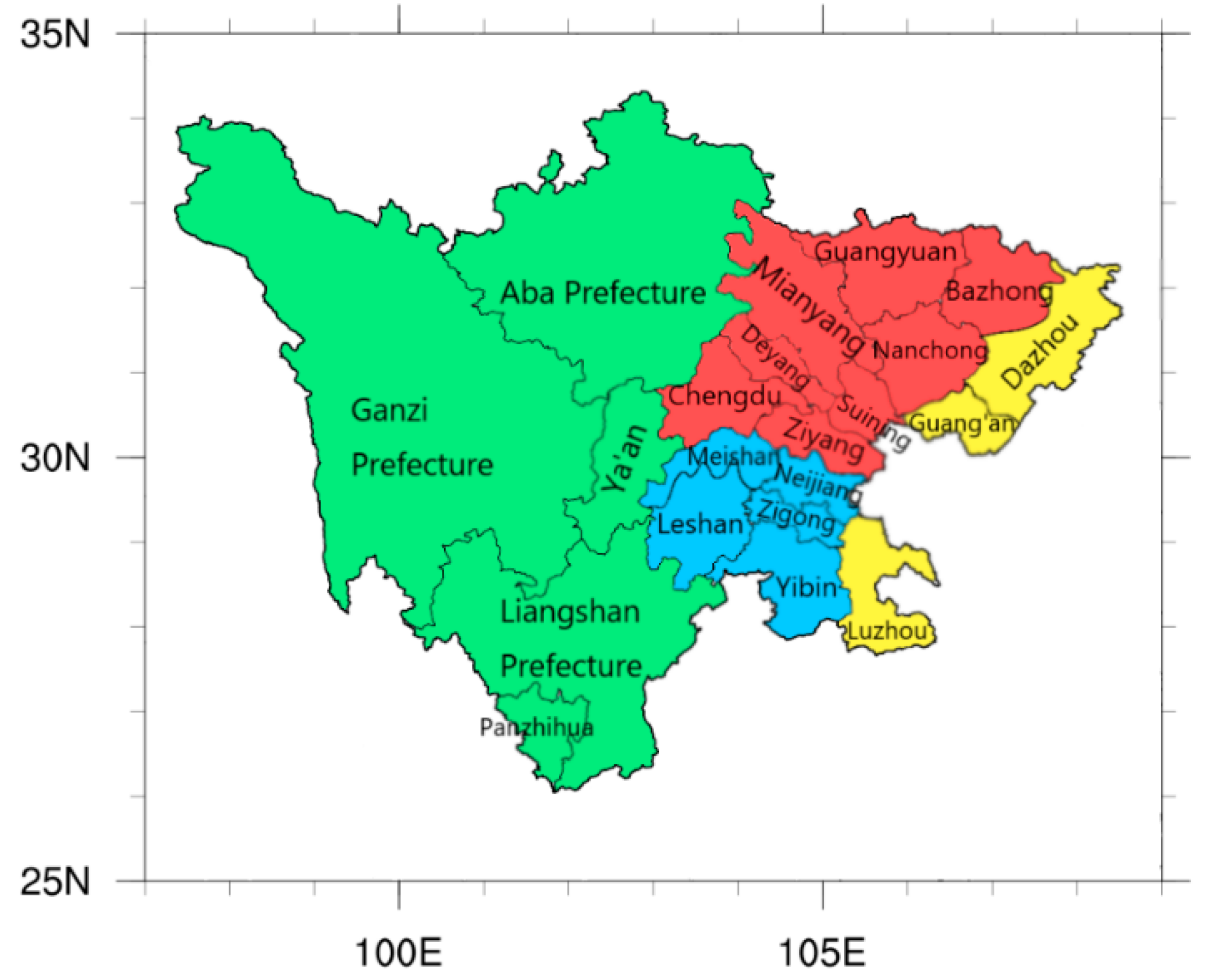
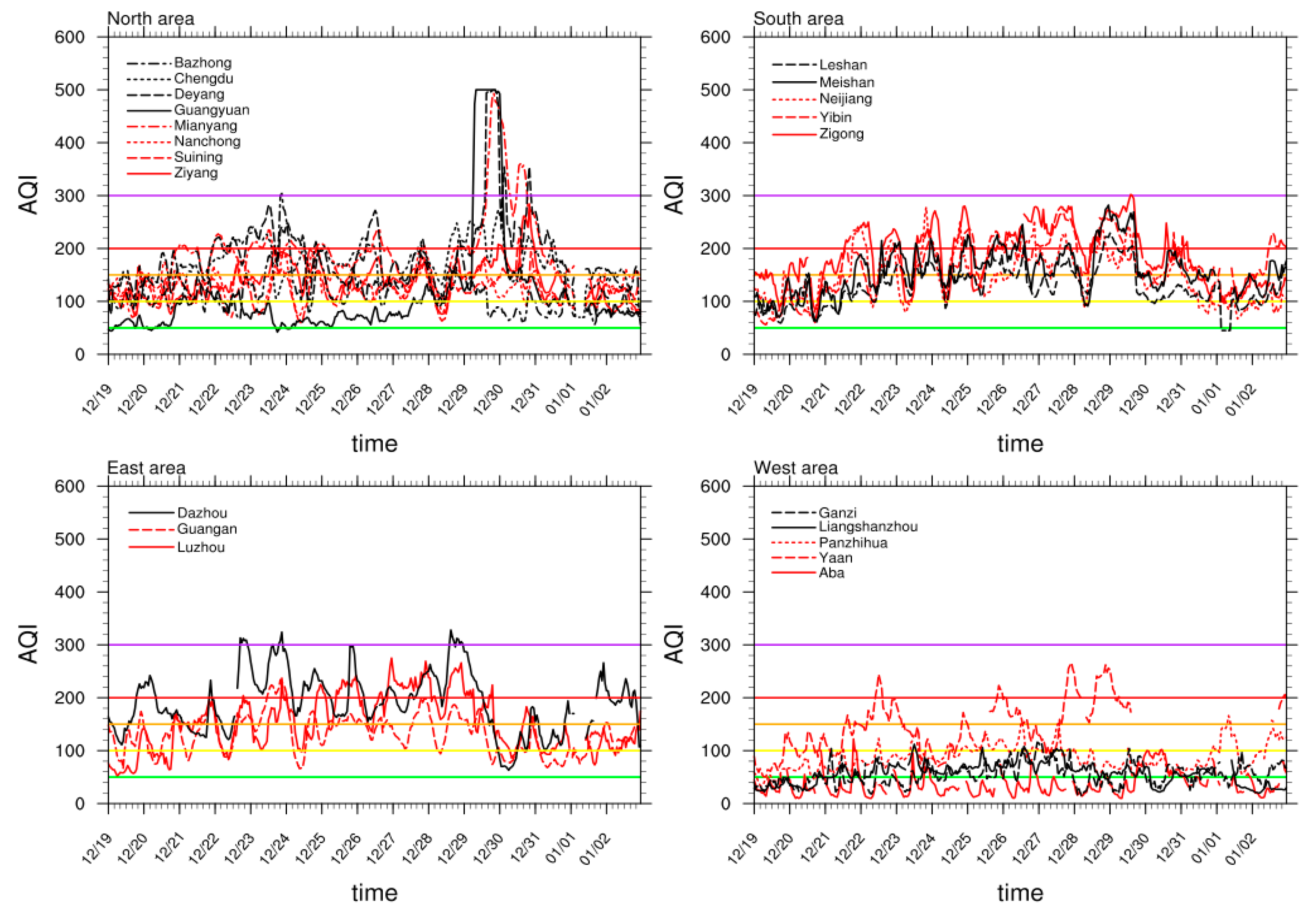
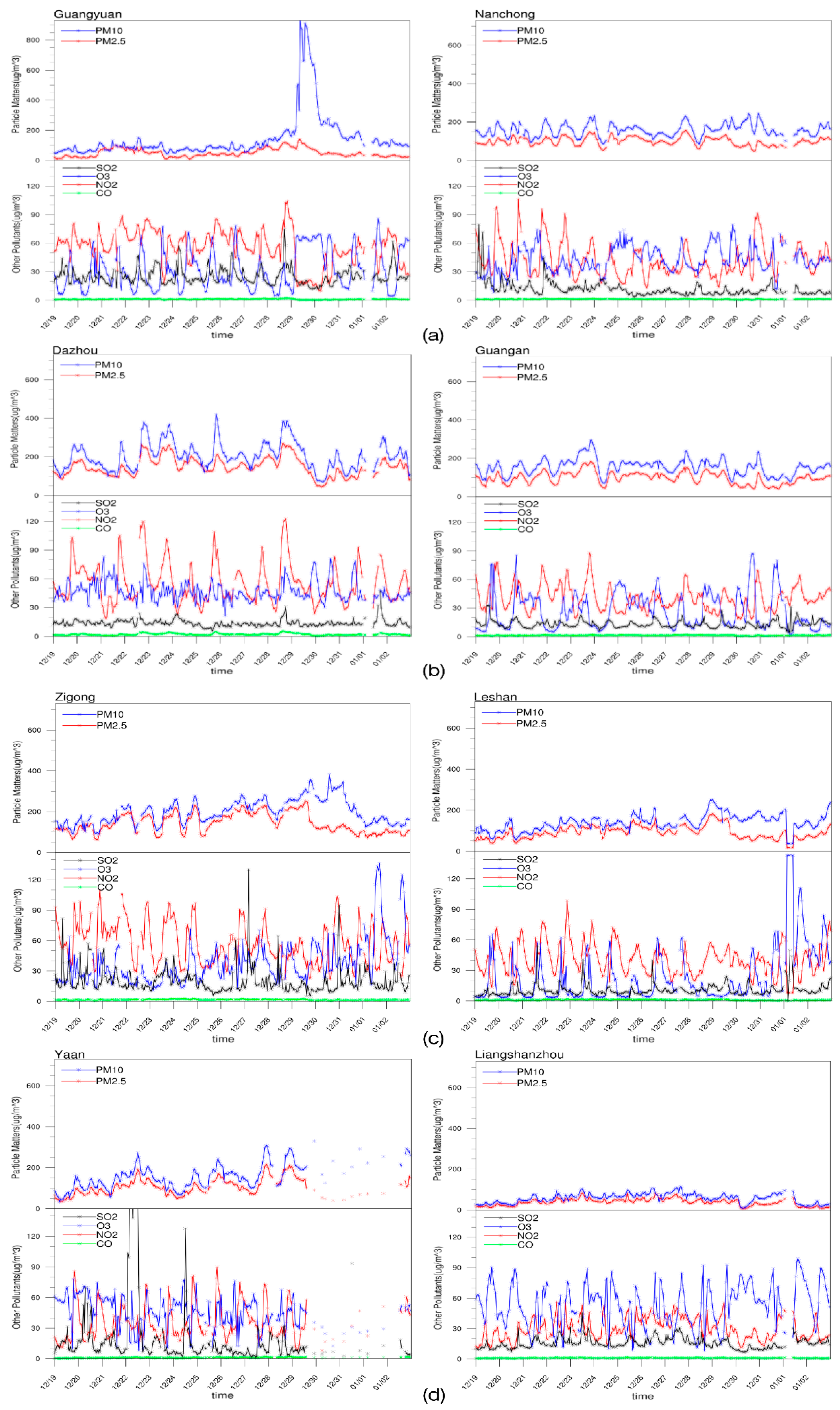
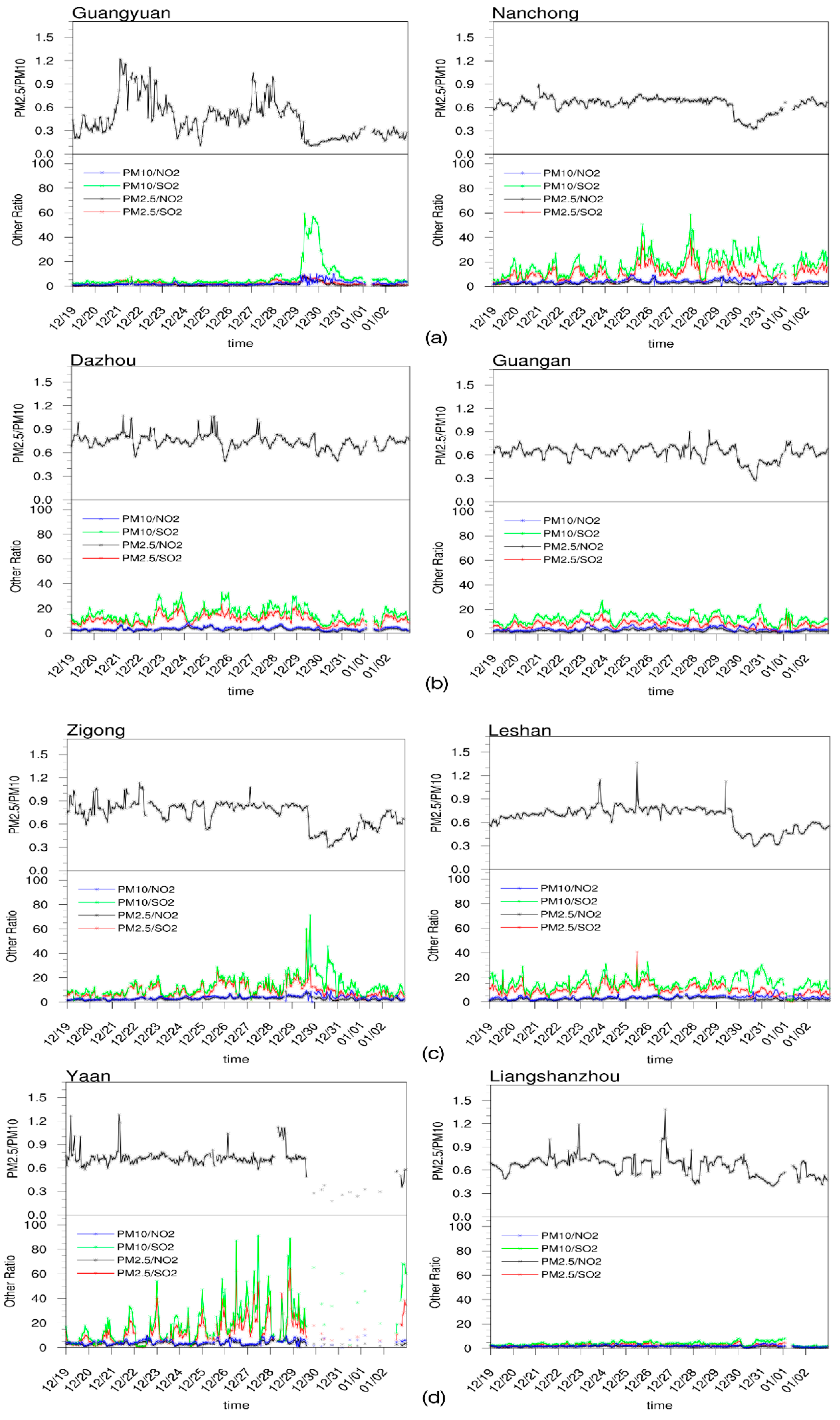

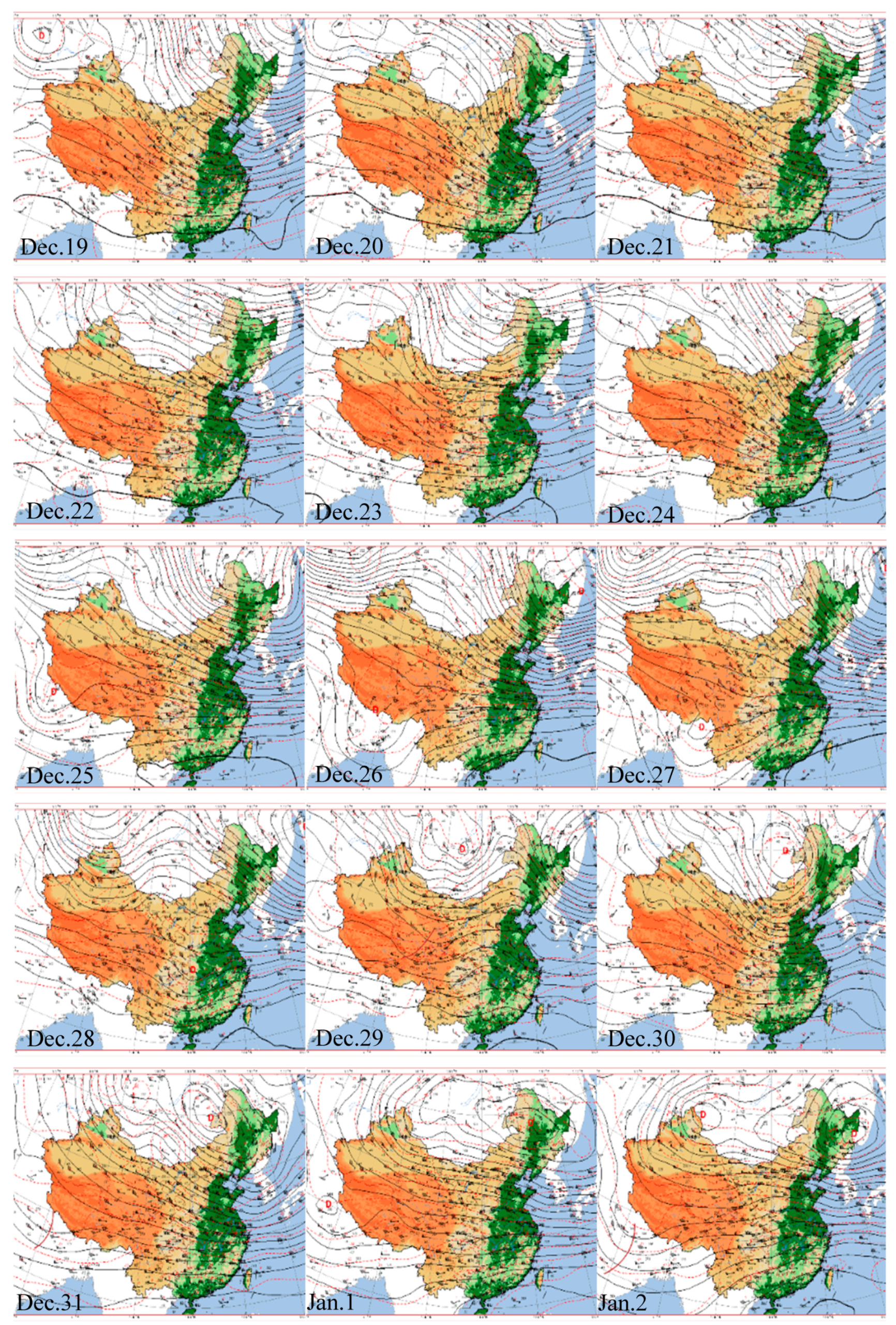

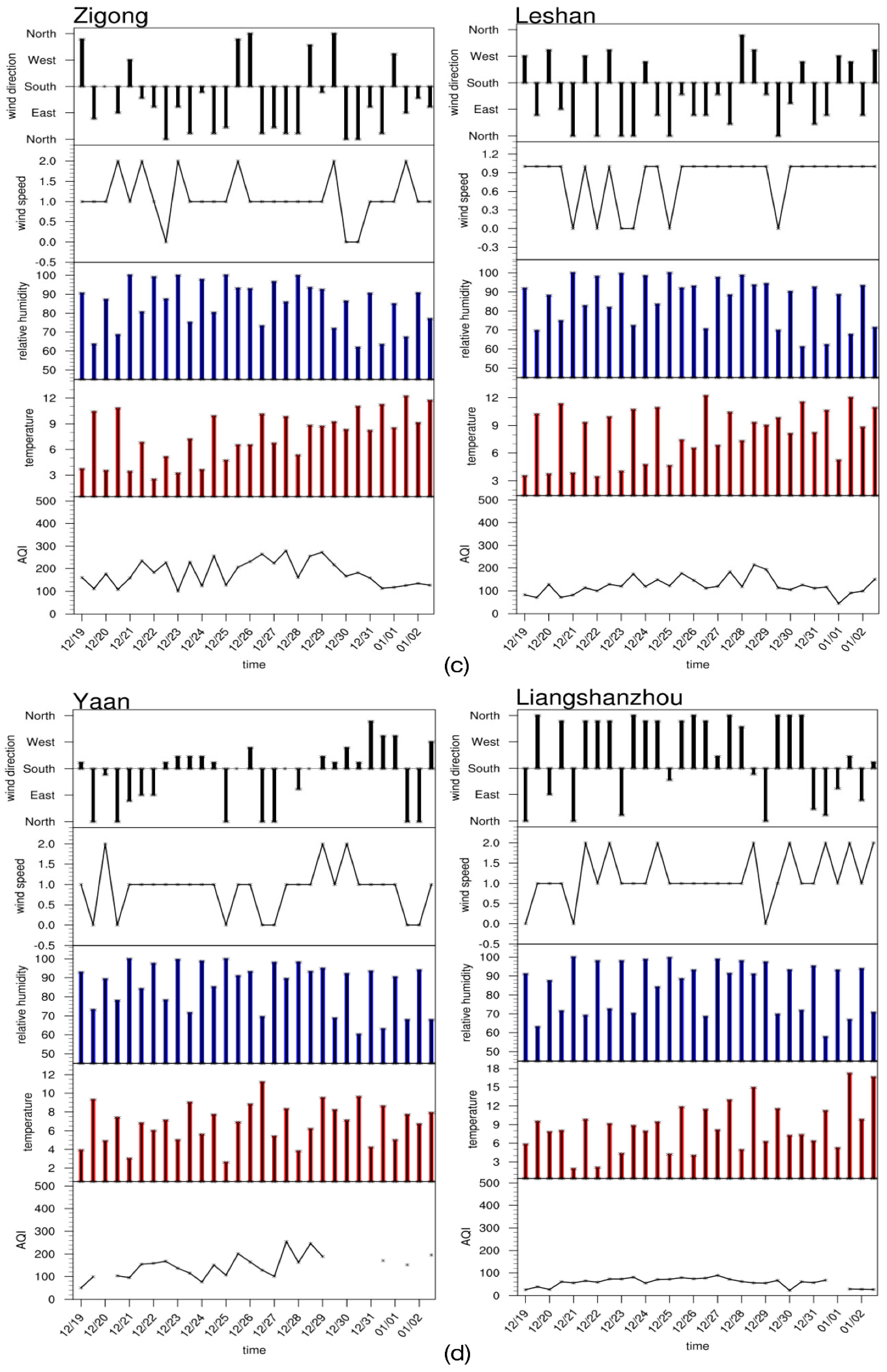

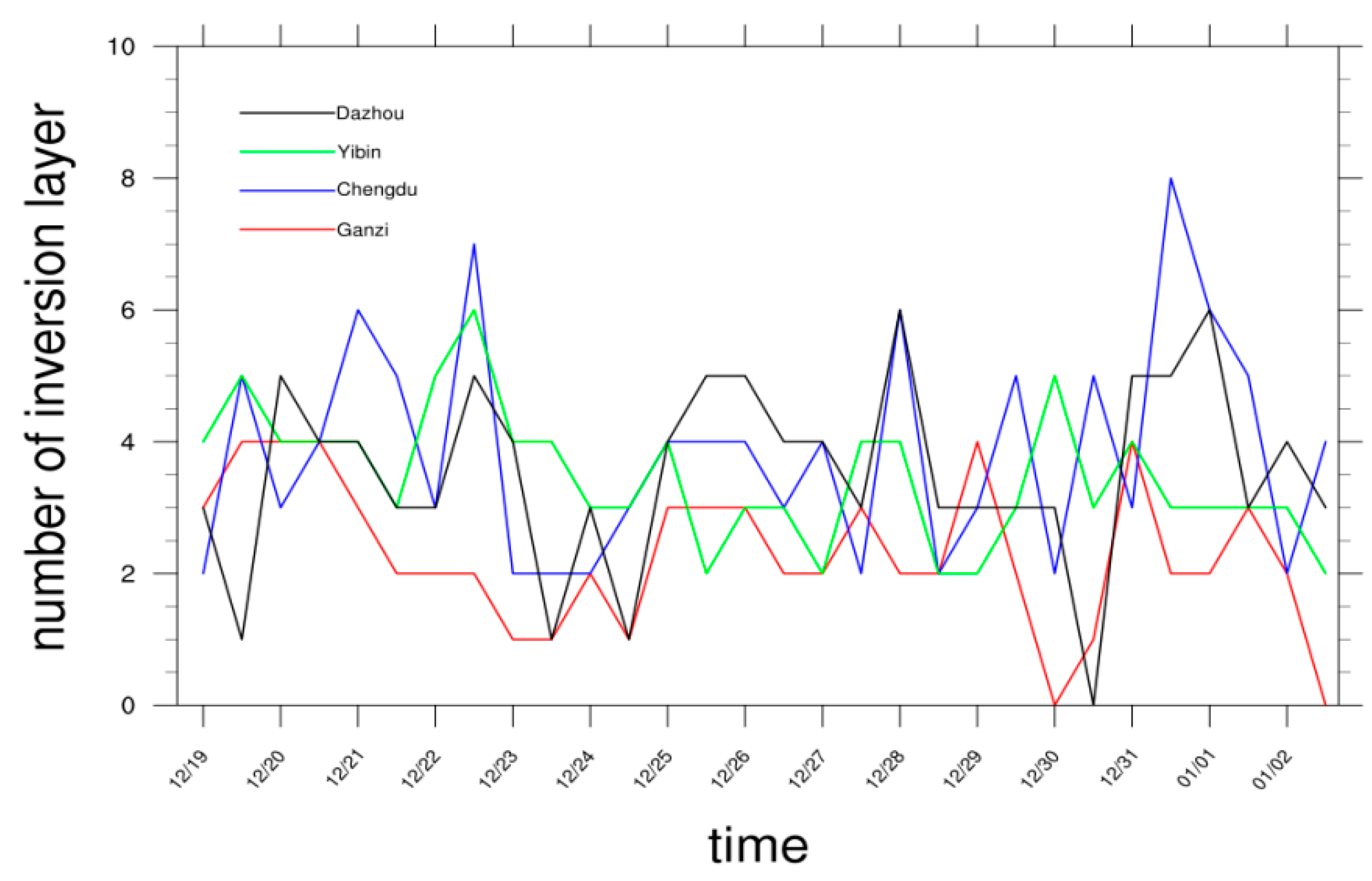
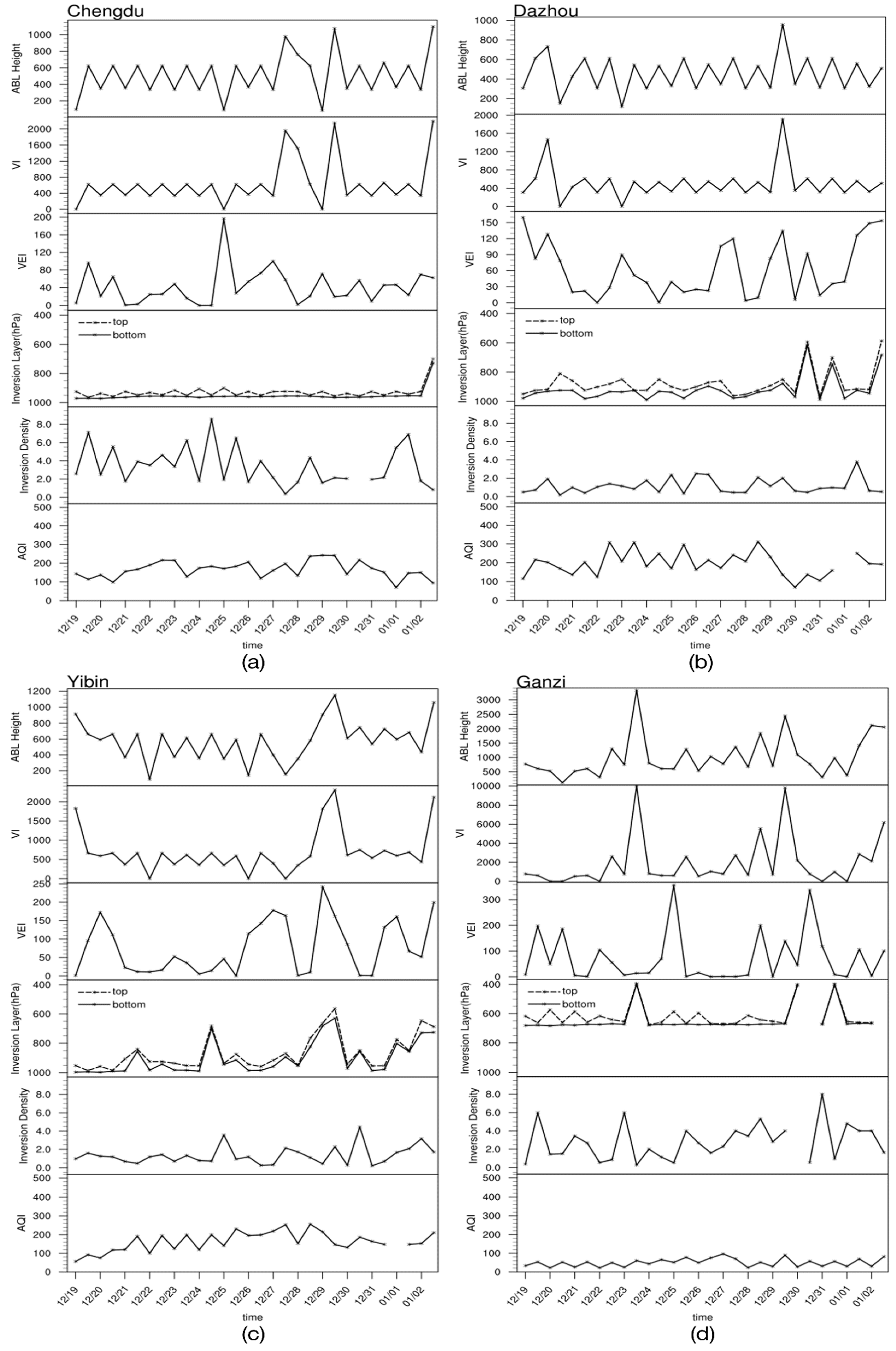
| AQI | Air Pollution Level | Health Implications |
|---|---|---|
| 0–50 | Excellent | No health implications. |
| 51–100 | Good | Few hypersensitive individuals should reduce outdoor exercise. |
| 101–150 | Lightly Polluted | Slight irritations may occur, individuals with breathing or heart problems should reduce outdoor exercise. |
| 151–200 | Moderately Polluted | Slight irritations may occur, individuals with breathing or heart problems should reduce outdoor exercise. |
| 201–300 | Heavily Polluted | Healthy people will be noticeably affected. People with breathing or heart problems will experience reduced endurance in activities. These individuals and elders should remain indoors and restrict activities. |
| 300+ | Severely Polluted | Healthy people will experience reduced endurance in activities. There may be strong irritations and symptoms and may trigger other illnesses. Elders and the sick should remain indoors and avoid exercise. Healthy individuals should avoid outdoor activities. |
| Region | City | PM10 | PM2.5 | NO2 | CO | SO2 | O3 | AQI | AQImax | Primary Pollutants |
|---|---|---|---|---|---|---|---|---|---|---|
| Northern Sichuan | Mianyang | 209.3 | 125.4 | 52.2 | 1.3 | 10.6 | 21.5 | 184.0 | 493 | PM2.5 |
| Guangyuan | 143.2 | 49.5 | 55.9 | 1.2 | 25.3 | 31.9 | 110.9 | 500 | PM10 | |
| Nanchong | 157.3 | 99.5 | 41.9 | 1.2 | 11.7 | 43.1 | 113.5 | 206 | PM2.5 | |
| Ziyang | 177.5 | 89.1 | 40.3 | 1.2 | 9.1 | 28.4 | 135.9 | 284 | PM2.5 and PM10 | |
| Deyang | 223.1 | 127.0 | 65.5 | 1.3 | 9.4 | 20.7 | 186.5 | 499 | PM2.5 | |
| Suining | 141.3 | 85.6 | 43.6 | 1.2 | 10.3 | 22.3 | 121.0 | 210 | PM2.5 | |
| Chengdu | 197.5 | 120.9 | 71.1 | 1.4 | 14.6 | 31.6 | 116.9 | 273 | PM2.5 | |
| Bazhong | 127.3 | 90.5 | 35.8 | 1.2 | 6.1 | 23.3 | 121.7 | 304 | PM2.5 | |
| Eastern Sichuan | Guang’an | 154.1 | 97.4 | 40.2 | 1.3 | 13.0 | 26.0 | 132.2 | 234 | PM2.5 |
| Luzhou | 174.7 | 110.9 | 59.9 | 1.2 | 19.5 | 19.0 | 151.8 | 275 | PM2.5 | |
| Dazhou | 203.7 | 148.9 | 55.4 | 2.1 | 13.7 | 47.0 | 191.6 | 328 | PM2.5 | |
| Southern Sichuan | Meishan | 186.9 | 112.7 | 59.5 | 0.8 | 12.2 | 26.0 | 158.0 | 282 | PM2.5 |
| Zigong | 198.4 | 142.9 | 57.2 | 1.5 | 20.0 | 37.8 | 186.4 | 302 | PM2.5 | |
| Yibin | 181.7 | 121.9 | 57.0 | 1.6 | 20.5 | 22.7 | 176.7 | 279 | PM2.5 | |
| Neijiang | 158.2 | 107.5 | 45.6 | 1.2 | 29.0 | 29.0 | 146.5 | 278 | PM2.5 | |
| Leshan | 139.2 | 91.6 | 40.9 | 1.1 | 10.7 | 23.3 | 127.9 | 229 | PM2.5 | |
| Western Sichuan | Aba | 36.7 | 18.5 | 13.7 | 0.6 | 11.1 | 42.2 | 37.1 | 122 | PM2.5 and PM10 |
| Ganzi | 51.7 | 32.8 | 15.8 | 0.4 | 14.4 | 63.1 | 54.2 | 116 | PM2.5 and PM10 | |
| Liangshan | 57.4 | 37.6 | 29.7 | 1.0 | 15.7 | 52.7 | 57.1 | 112 | PM2.5 | |
| Panzhihua | 116.4 | 55.2 | 58.3 | 2.6 | 39.5 | 29.3 | 86.4 | 166 | PM10 | |
| Ya’an | 155.4 | 107.5 | 35.1 | 1.1 | 20.3 | 45.6 | 143.7 | 266 | PM2.5 |
| City | PM2.5 | PM10 | CO | NO2 | O3 | SO2 | ||
|---|---|---|---|---|---|---|---|---|
| Northern Sichuan | Guangyuan | Wind Speed | 0.058 | 0.258 * | −0.364 * | −0.290 * | 0.476 * | −0.025 |
| Relative Humidity | 0.064 | 0.346 | 0.220 | −0.183 | −0.613 * | −0.180 | ||
| Temperature | 0.058 | 0.352 * | −0.249 * | −0.221 * | 0.691 * | −0.032 | ||
| ABL | −0.037 | 0.292 * | −0.490 * | −0.318 * | 0.666 * | 0.003 | ||
| VI | 0.017 | 0.312 * | −0.466 * | −0.355 * | 0.649 * | −0.010 | ||
| VEI | −0.118 | 0.100 | −0.031 | 0.089 | 0.092 | 0.032 | ||
| Nanchong | Wind Speed | 0.023 | 0.047 | −0.079 | −0.206 * | 0.406 * | −0.043 | |
| Relative Humidity | −0.404 * | −0.629 | −0.473 * | −0.809 | −0.391 * | 0.323 | ||
| Temperature | 0.121 | 0.270 * | −0.081 | 0.235 * | 0.282 * | −0.396 * | ||
| ABL | −0.006 | 0.136 | −0.168 | −0.079 | 0.381 * | −0.081 | ||
| VI | 0.028 | 0.151 | −0.128 | −0.083 | 0.425 * | −0.091 | ||
| VEI | 0.245 | 0.158 | −0.081 | 0.121 | 0.045 | −0.400 * | ||
| Eastern Sichuan | Dazhou | Wind Speed | −0.108 | −0.085 | −0.111 | −0.107 | 0.197 * | −0.045 |
| Relative Humidity | −0.255 | −0.462 * | −0.165 | −0.668 * | −0.253 | −0.107 | ||
| Temperature | 0.224 * | 0.308 * | −0.268 * | 0.492 * | 0.303 * | 0.013 | ||
| ABL | 0.003 | 0.093 | −0.028 | 0.253 * | 0.367 * | 0.003 | ||
| VI | 0.031 | 0.107 | −0.030 | 0.187 * | 0.313 * | 0.014 | ||
| VEI | −0.017 | 0.001 | 0.045 | 0.043 | −0.026 | −0.290 | ||
| Guang’an | Wind Speed | 0.076 | 0.101 | 0.118 | 0.189 * | 0.111 | 0.116 | |
| Relative Humidity | −0.265 | −0.272 | 0.137 | −0.540 * | −0.255 | −0.101 | ||
| Temperature | 0.053 | 0.103 | 0.072 | 0.199 * | 0.109 | 0.224 * | ||
| ABL | 0.083 | 0.094 | 0.030 | 0.091 | 0.087 | −0.109 | ||
| VI | 0.070 | 0.105 | 0.094 | 0.196 * | 0.120 | 0.114 | ||
| VEI | −0.101 | −0.101 | −0.055 | 0.188 | −0.285 | 0.197 | ||
| Southern Sichuan | Zigong | Wind Speed | −0.054 | −0.074 | 0.083 | 0.081 | 0.116 | 0.131 |
| Relative Humidity | 0.055 | −0.314 | 0.306 | −0.742 * | −0.454 * | 0.202 | ||
| Temperature | −0.072 | −0.006 | −0.005 | 0.132 | 0.207 * | 0.045 | ||
| ABL | −0.019 | 0.006 | 0.002 | 0.151 | 0.187 * | 0.079 | ||
| VI | −0.075 | −0.066 | 0.041 | 0.095 | 0.158 | 0.110 | ||
| VEI | 0.027 | 0.011 | −0.039 | 0.096 | 0.115 | −0.141 | ||
| Leshan | Wind Speed | −0.087 | 0.127 | −0.294 * | −0.204 * | 0.309 * | 0.160 | |
| Relative Humidity | 0.223 | −0.193 | 0.293 | −0.601 * | −0.737 * | −0.153 | ||
| Temperature | −0.011 | 0.253 * | 0.323 * | 0.148 | 0.782 * | 0.427 * | ||
| ABL | −0.173 | 0.169 | −0.488 * | 0.026 | 0.617 * | 0.280 * | ||
| VI | −0.167 | 0.163 | −0.463 * | 0.015 | 0.579 * | 0.269 * | ||
| VEI | 0.143 | 0.060 | 0.103 | −0.117 | 0.204 | 0.165 | ||
| Western Sichuan | Ya’an | Wind Speed | −0.167 | −0.187 | −0.315 * | −0.537 * | −0.029 | 0.157 |
| Relative Humidity | 0.070 | −0.522 * | −0.491 * | −0.589 * | 0.034 | 0.348 | ||
| Temperature | 0.019 | 0.134 | 0.026 | −0.147 | −0.244 * | −0.026 | ||
| ABL | −0.162 | −0.111 | −0.319 * | −0.486 * | −0.087 | 0.049 | ||
| VI | −0.161 | −0.125 | −0.315 * | −0.510 * | −0.103 | 0.105 | ||
| VEI | 0.181 | 0.145 | 0.156 | 0.154 | −0.165 | −0.234 | ||
| Liangshan | Wind Speed | −0.192 * | −0.206 * | −0.260 * | −0.160 | 0.422 * | 0.075 | |
| Relative Humidity | −0.017 | 0.012 | 0.386 * | 0.321 | −0.742 * | −0.043 | ||
| Temperature | 0.098 | −0.072 | −0.280 * | −0.129 | 0.420 * | 0.439 * | ||
| ABL | −0.350 * | −0.318 * | −0.430 * | −0.384 * | 0.526 * | 0.182 | ||
| VI | −0.340 * | −0.322 * | −0.412 * | −0.343 * | 0.553 * | 0.148 | ||
| VEI | −0.153 | 0.159 | 0.043 | 0.083 | 0.055 | 0.199 |
© 2019 by the authors. Licensee MDPI, Basel, Switzerland. This article is an open access article distributed under the terms and conditions of the Creative Commons Attribution (CC BY) license (http://creativecommons.org/licenses/by/4.0/).
Share and Cite
Zeng, S.; Zheng, Y. Analysis of a Severe Pollution Episode in December 2017 in Sichuan Province. Atmosphere 2019, 10, 156. https://doi.org/10.3390/atmos10030156
Zeng S, Zheng Y. Analysis of a Severe Pollution Episode in December 2017 in Sichuan Province. Atmosphere. 2019; 10(3):156. https://doi.org/10.3390/atmos10030156
Chicago/Turabian StyleZeng, Shenglan, and Yiyu Zheng. 2019. "Analysis of a Severe Pollution Episode in December 2017 in Sichuan Province" Atmosphere 10, no. 3: 156. https://doi.org/10.3390/atmos10030156
APA StyleZeng, S., & Zheng, Y. (2019). Analysis of a Severe Pollution Episode in December 2017 in Sichuan Province. Atmosphere, 10(3), 156. https://doi.org/10.3390/atmos10030156




